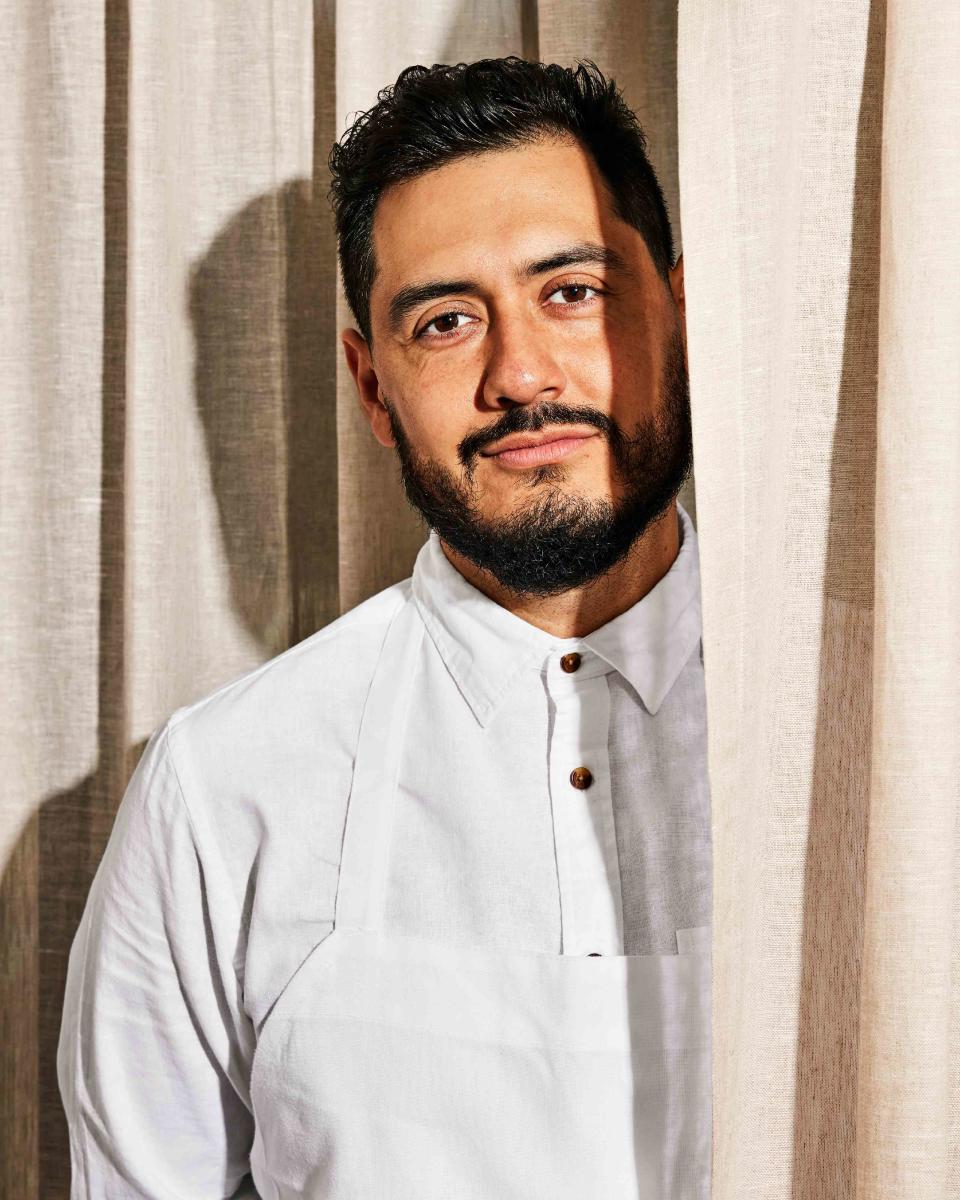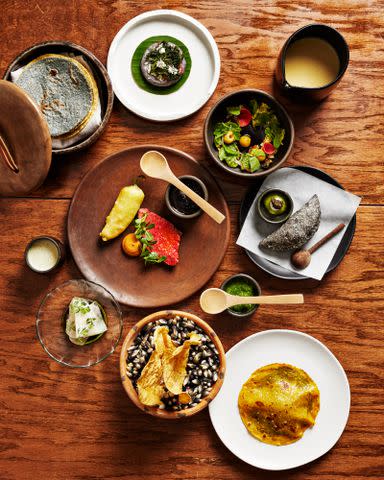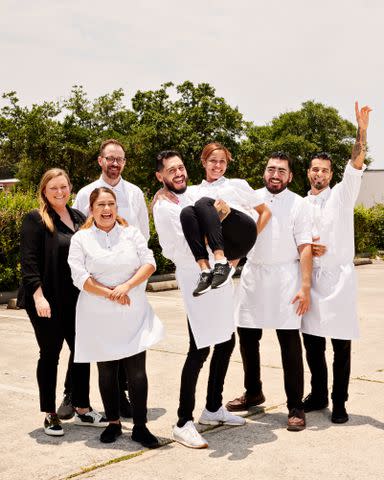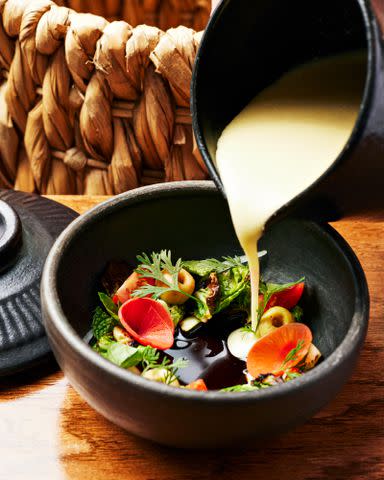From Masa Pancakes to Corn Ice Cream, Emmanuel Chavez Is All About the Maize
From fluffy masa pancakes to a silky, corn-infused ice cream, maize is the lifeblood of this chef’s boundary-expanding menu at Tatemó in Houston.

Eva Kolenko
There is little that matters more to Emmanuel Chavez than maize. The chef nixtamalizes 80 pounds of masa a week at his Houston restaurant Tatemó, and corn is everywhere on the menu. For the restaurant’s fluffy pancakes, Chavez dehydrates masa before turning it into a flour and mixing it with buttermilk. For the kampachi ceviche that often kicks off the tasting menu, the chef tosses pieces of the fatty fish with lime juice, fish sauce, white soy sauce, and gently sweet corn milk (the liquid released from a fresh corn cob). A plate of enmoladas features maize two ways: first in the lissome tortilla that arrives packed with oyster mushrooms and also in the mole negro that drenches the dish made with blackened leftover tortillas, dashi, several types of chile, and galletas María, a beloved Mexican cookie. Even dessert pushes the boundaries of corn: A crispy masa flour buñuelo is served with a scoop of masa ice cream and a silky mousse made from corn cobs steeped in buttermilk and heavy cream.
There isn’t a single dish that does not use maize in one format or another — it is the lifeblood of the restaurant. (At one point, the restaurant was working with over 30 different varieties of corn.) “Anything we put on any menu, a maize product has to be involved somehow,” Chavez says. “Whether that is as a tortilla, as a flour, as a tempura, or [something sweet].” It’s all part of his mission to showcase the diversity of heirloom corn, especially from Mexican farmers, and to “restore the cultural value of maize.”

Eva Kolenko
The tasting menu includes (from top left) tortillas, gordita de Jamaica, corn bisque with masa dumplings, fried quesadilla with guacasalsa and sturgeon caviar, (middle) strip loin with masa tempura chile relleno, (bottom left) kampachi ceviche with corn milk, and tostadas de maÃz bolitaThe name of the restaurant is a reflection of that mission, too. Tatemó comes from tatemar, the Spanish verb meaning to “toast, roast, or grill.” It’s a name that deliberately invokes a fundamental technique in Mexican cooking. “If you know anything about French cuisine, it’s very technique driven. They’re very prideful with their techniques. Japanese cuisine, too,” he says. He wants more people like himself to take pride in the nuances and sophistication of Mexican cuisine. “I’m a primary example of that. Even though I was born in Mexico, I had no idea how a real tortilla was made.”
Chavez’s family immigrated to Houston when he was 10 years old. Though he grew up in the Tex-Mex restaurant where his parents worked, eventually washing dishes and doing prep work in the kitchen himself, it wasn’t until he moved to Seattle as a young chef that he first learned about nixtamalization and the craft of proper tortilla making. He moved to the city from Texas to help open a hotel restaurant, later working for chef Eric Rivera. Chavez was costing out ingredients for a charity dinner when Rivera noticed he had a bag of low-quality instant masa on the list. Rivera pulled him aside and scolded him for using “sh-t ingredients,” recalls Chavez. “He said, ‘If you ever want to be taken seriously in this industry, you have to know where you come from.” It’s advice that shifted the trajectory of Chavez’s career. “Basically, I didn’t know anything about my actual culture,” says Chavez. “So it became my obsession to figure out who I was.”
Related: This Best New Chef Knows Where to Find the Most ‘Iconic’ Barbecue in Houston
He returned to Houston with his girlfriend and future business partner, Megan Maul, with the idea that he would eventually open a 130-seat restaurant with investors. He purchased a molino for grinding corn and started practicing making masa, learning several techniques from YouTube videos and testing them out until he could execute them with confidence.

Eva Kolenko
Team Tatemó, including partner/owner Megan Maul (far left)When the pandemic hit, Chavez and Maul looked around and realized the restaurant was not going to work out and that they had a “sh-t ton of bags of corn and a lot of time on [their] hands.” So they started making and selling masa and tortillas by the pound through social media, eventually selling at a local farmers market. At one point, they were making 2,400 tortillas out of their tiny apartment to keep up with demand.

Eva Kolenko
Corn bisque with masa dumplingsRestaurants began calling the couple to buy tortillas and masa wholesale. Chavez invested in more equipment, moved to a ghost kitchen, and hired a few team members to help run the operation. He missed cooking and began hosting regular dinners in the space. When they were forced to find a new venue in 2021, Chavez stumbled upon the perfect location while on the hunt for a Cuban sandwich: a vacant juice shop in a quiet strip mall. They signed a lease, put $20,000 toward minor renovations, and opened Tatemó in 2021.
Related: Every Food & Wine Best New Chef Ever, Since 1988
Today, the space is still scrappy and bare-bones: There is no sign on the front door, minimal art on the walls, and even less furniture — but it is surprisingly charming, nonetheless. Tatemó can seat just 16 diners for the tasting menu, two seatings a night, four nights a week, plus Sunday brunch service. Space and staffing constraints mean Chavez and his team have had to stop doing the wholesale tortilla business to focus on the restaurant, but he is hoping to change that in the near future and is actively looking for a second location to build out a proper tortilleria. “I want to go back to selling masa and tortillas to restaurants,” he says. “I feel like it’s our responsibility to bring Mexican cuisine forward, to ensure that the knowledge doesn’t die, and that we are starting conversations at a table. And it starts with a tortilla, as simple as that sounds.”
For more Food & Wine news, make sure to sign up for our newsletter!
Read the original article on Food & Wine.

